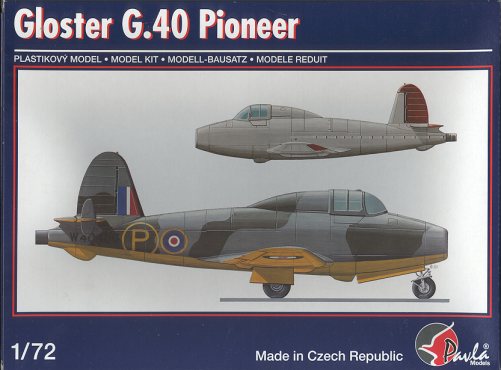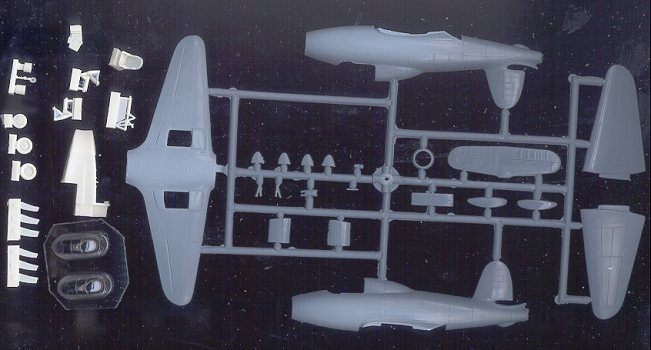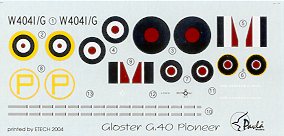
| KIT: | Pavla 1/72 Gloster G.40 Pioneer |
| KIT #: | 72055 |
| PRICE: | $21.98 ($19.96 at Squadron) |
| DECALS: | Two options |
| REVIEWER: | Scott Van Aken |
| NOTES: | Short run with vacuform canopy and resin parts |

| HISTORY |
The first recorded jet flight in Britain took place on May 15 1941 when Gloster E28/39, W4041/G, fitted with a Whittle W1 jet engine, took off from RAF Cranwell, piloted by Gerry Sayer. Though many think this was the first jet flight, that honor goes to the He-178 which was first flown in August of 1939, nearly two years earlier.
The E28/39 was sent to Farnborough late in 1942 for testing by service pilots. The first man to do so was Wing Commander HJ Wilson who, in 1945, established a world air speed record of 606mph in a Meteor F3. W4041/G (the G meaning it was to be kept under armed guard at all times) was joined in May 1943 by a second machine fitted with the more powerful W2B engine. While testing the latter in July 1943, Squadron Leader Douglas Davie had the dubious distinction of becoming the first man to bail out of a jet aircraft when he was forced to abandon his machine because the ailerons had jammed. W4041/G was transferred to the Science Museum in April 1946.
| THE KIT |

This kit is typical of the latest offerings from Pavla. There is one sprue on which the major parts for the airframe are molded. The large parts (wings, fuselage) have rather big ejector towers that should be removed before construction. These parts are finely engraved and the fabric representation on the control surfaces is actually quite nicely done. The gear doors are molded in the closed position and must be cut open by the builder. They are a bit too thick and so some sanding to reduce this thickness should help its appearance considerably.
There are two nicely molded vacuform canopies made of nice, thick plastic so gluing will be much easier! Resin is used for the rest of the parts. The cockpit tub and nose gear are one piece and nicely molded. The six 'slivers' of resin are to be glued on each side of the cockpit tub as these are apparently in there to enhance air flow to the engine. The seat, control column, landing gear, wheels exhaust and a few other bits are in resin. The main gear are superbly molded and quite complex looking. What isn't provided is a place to put nose weight. I'm not sure if this will be a tail sitter or not and perhaps the resin cockpit is weight enough. One thing for sure, it will be interesting to see how long the nose gear holds up before it starts deforming under the weight.
 Instructions are quite good as
we've come to expect from Pavla. Half of the pages are taken up by painting
and decal markings. The only option is to add the small finlets for
later versions and there are two tailpipe lengths. The 'first flight'
scheme is listed as aluminum dope with brown/red (i.e. primered) fabric
control surfaces. The other two options are in Dark Earth/Dark Green over
Yellow as is appropriate for a prototype. The decals look superbly printed
and will undoubtedly work just fine.
Instructions are quite good as
we've come to expect from Pavla. Half of the pages are taken up by painting
and decal markings. The only option is to add the small finlets for
later versions and there are two tailpipe lengths. The 'first flight'
scheme is listed as aluminum dope with brown/red (i.e. primered) fabric
control surfaces. The other two options are in Dark Earth/Dark Green over
Yellow as is appropriate for a prototype. The decals look superbly printed
and will undoubtedly work just fine.
| CONCLUSIONS |
To my knowledge, this is the third 1/72 injected kit done of this aircraft. First was the Frog kit of the late 1960s, followed by the High Planes version back in the late 1990s. This is by far the best representation of the aircraft and it will be hard to top. If your interest is in pioneering aircraft, then this one should be on your shelves right next to the He-178 and X-1.
You can find this kit and many others at

If you would like your product reviewed fairly and quickly by a site that has over 250,000 visitors a month, please contact me or see other details in the Note to Contributors.